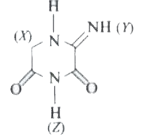Two compounds PX2Y3andPX3Y2 (Where P=phosphorous atom and X, Y= monovalent atoms). If all 'X' atoms are replaced by 'Z' atoms and electronegativity order is X>Y>Z. Then incorrect statement (s) is/are:
The dipole moment of product obtained from PX2Y3 is non-zero
The dipole moment of product obtained from PX2Y3 is zero
The dipole moment of product obtained from PX3Y2 is zero
The dipole moment of product obtained from PX3Y2 is non-zero
The correct Answer is:B, D
To solve the problem, we need to analyze the two compounds PX2Y3 and PX3Y2 in terms of their molecular geometry and dipole moments after replacing all 'X' atoms with 'Z' atoms, given the electronegativity order X>Y>Z.
Step 1: Analyze the structure of PX2Y3
1. Identify the arrangement: In PX2Y3, phosphorus (P) is the central atom. Given that X has a higher electronegativity than Y, the X atoms will occupy the axial positions to minimize repulsion.
2. Determine the molecular geometry: The geometry of PX2Y3 is trigonal bipyramidal, with X atoms in axial positions and Y atoms in equatorial positions.
3. Evaluate the dipole moment: The dipole moments of the X atoms will cancel each other out due to symmetry, and the dipole moments of the Y atoms will also cancel each other out. Therefore, the overall dipole moment of PX2Y3 is zero.
Step 2: Replace X with Z in PX2Y3
1. New compound: After replacing X with Z, we get PZ2Y3.
2. Re-evaluate the arrangement: Since Z has a lower electronegativity than Y, Z atoms will occupy the equatorial positions, and Y atoms will occupy the axial positions.
3. Determine the dipole moment: The dipole moments of the Y atoms will not cancel out, as they are in the axial positions. Therefore, the dipole moment of PZ2Y3 is non-zero.
Step 3: Analyze the structure of PX3Y2
1. Identify the arrangement: In PX3Y2, X atoms will again occupy the axial positions due to their higher electronegativity compared to Y.
2. Determine the molecular geometry: The geometry remains trigonal bipyramidal, with X in axial positions and Y in equatorial positions.
3. Evaluate the dipole moment: Similar to the previous case, the dipole moments of the X atoms will cancel each other out, but the Y atoms will create a net dipole moment. Thus, the overall dipole moment of PX3Y2 is non-zero.
Step 4: Replace X with Z in PX3Y2
1. New compound: After replacing X with Z, we get PZ3Y2.
2. Re-evaluate the arrangement: The Z atoms will occupy the equatorial positions, while the Y atoms will occupy the axial positions.
3. Determine the dipole moment: The dipole moments of the Y atoms will not cancel out, leading to a non-zero dipole moment for PZ3Y2.
Conclusion
Based on the analysis, the incorrect statements regarding the dipole moments of the compounds after replacing X with Z are:
- The dipole moment of PZ2Y3 is non-zero (this is incorrect as it should be zero).
- The dipole moment of PZ3Y2 is zero (this is incorrect as it should be non-zero).
2. Determine the molecular geometry: The geometry of PX2Y3 is trigonal bipyramidal, with X atoms in axial positions and Y atoms in equatorial positions.
- The dipole moment of PZ3Y2 is zero (this is incorrect as it should be non-zero).
Topper's Solved these Questions
- CHEMICAL BONDING (ADVANCED)BOOK - VK JAISWAL ENGLISHCHAPTER - CHEMICAL BONDING (ADVANCED)EXERCISE - MATCH THE COLUMN
21 Videos
- CHEMICAL BONDING (ADVANCED)BOOK - VK JAISWAL ENGLISHCHAPTER - CHEMICAL BONDING (ADVANCED)EXERCISE - ASSERTION-REASON TYPE QUESTIONS
57 Videos
- CHEMICAL BONDING (ADVANCED)BOOK - VK JAISWAL ENGLISHCHAPTER - CHEMICAL BONDING (ADVANCED)EXERCISE - Level 3
77 Videos
- CHEMICAL BONDING (BASIC)BOOK - VK JAISWAL ENGLISHCHAPTER - CHEMICAL BONDING (BASIC)EXERCISE - SUBJECTIVE PROBLEMS
54 Videos
Similar Questions
Knowledge Check
Three elements X , Y and Z have atomic numbers 19 , 37 and 55 respectively . Then the correct statement (s) is / are
ATheir ionization potential would increase with increasing atomic number.BY would have an ionization potential between those of X and Z.CZ would have the highest ionization potential.DY would have the highest ionization potential.Consider a Py orbital of an atom and identify correct statement
As-orbital of another atom produces π-bond when y is the bond formation axisBpy-orbital of another atom produces σ-bond when x is the bond formation axis.Cpz-orbital of another atom produces π-bond when x is the bond formation axis.Ddxy-orbital of another atom produces π-bond when x is the bond formation axis The correct basicity order of atoms X, Y and Z is :AX>Y>ZBZ>Y>XCZ>X>YDY>X>Z
The correct basicity order of atoms X, Y and Z is :AX>Y>ZBZ>Y>XCZ>X>YDY>X>Z
Ionistable H atom in H3PO3 is x and in H3PO2 is y. Then ratio of x:y is
View SolutionConsider the following three compounds (i)AXn−2n, (ii)AX3n and (ii)AXn+4n, where central atom A is 15th group element and their maximum covalency is 3n. If total number of proton in surrounding atom X is n and value of n is one, then calculate value of x3+y2+z2 . (where x, y and z are total number of lone pair at central atom in compounds (i), (ii) and (iii) respectively.
View SolutionConsider the following three compounds (i)AXn−2n, (ii)AX3n and (ii)AXn+4n, where central atom A is 15th group element and their maximum covalency is 3n. If total number of proton in surrounding atom X is n and value of n is one, then calculate value of x3+y2+z2 . (where x, y and z are total number of lone pair at central atom in compounds (i), (ii) and (iii) respectively.
View SolutionIn a ccp structure of X atoms, Y atoms occupy all the octahedral holes. If 2X atom are removed from corners and replaced by Z, then the formula of the compound will be
View SolutionIn a lattice of X and Y atoms, If X atoms are present at corners and Y atoms at the body centre & one X atom is removed from a corner from each unit cell, then the formula of the compound will be:
View Solution

